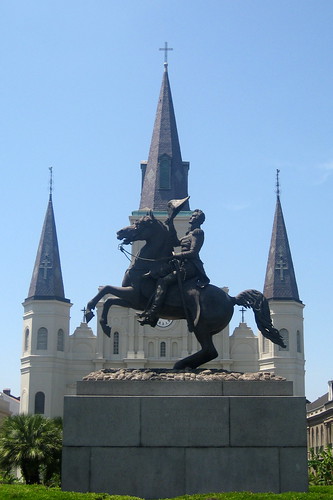
Jackson Square, a rectangular plot of land, roughly the size of a city-block, marks the site of the original settlement of New Orleans by the French Mississippi Company. Known at the time as Place d’Armes, it was designed in 1721 by landscape architect, Louis H. Pilié. It originally served as military parade grounds, and later as a market place and site for executions. Today it is a well manicured park and the spiritual center of the French Quarter.
From 1762-1803, after New Orleans was ceded to Spain in the Treaty of Paris and served as the Capital of the French Province of Louisiana, it bore the spanish translation of its original name, Plaza de Armas. After being returned to French control in 1801, the city was part of the land sold to the United States in the Louisiana purchase in 1803. It was in the Place d’Armes that the American flag was first raised over the newly purchased territory.
After the Battle of New Orleans, the final major battle of the War of 1812, the plaza was renamed in honor of General Andrew Jackson, an American military commander in the battle who would go on to serve as the seventh President of the United States, from 1829-1837. In 1856 the Baroness Celestin Pontalba paid for the square’s beautification. Under her auspices, the Pelanne brothers designed the wrought-iron fence surrounding the park and on February 8, 1856, sculptor Clark Mills’ equestrian statue of Jackson was dedicated in the center of the park. The statue, one of three identical casts (the others are in Washington D.C. and Nashville, TN), depicts General Jackson reviewing his troops at the Battle and was the first to ever depict a hero astride a rearing horse. After occupying the city after the Civil War’s Battle of New Orleans in 1862, Union General Benjamin "Beast" Butler engraved "The Union Must and Shall Be Preserved" on the plinth.
Surrounding the park is a pedestrian plaza. Diverse artists rent space and hang their works on the fence, and jazz musicians, tarot card readers, and clowns entertain throngs of tourists. When originally laid out, the plaza overlooked the Mississippi River, but the view was blocked in the 19th century by larger levees. Under the administration of Mayor Moon Landrieu, a scenic boardwalk, known as Moon Walk, was built along the river. Flanking the uptown and downtown sides of the Square, are the Pontalba Buildings, matching red-brick block long 4-story buildings erected in the 1840’s. The ground floors house shops and restaurants; the upper floors are apartments that are the oldest continuously rented in America.
On the Place John Paul II, the promenaded section of Chartres Street stretching the last length of the park, sit three historic buildings financed by Don Andrès Alomonester y Rojas, the Baroness Pontalba’s father. The center of the three is St. Louis Cathedral. To its left is the Cabildo, built in 1795. It served as the capitol for the Spanish colonial government, then later as City Hall, and home of the State Supreme Court, and today houses the Louisiana State Museum. It was here that the finalization of the Louisiana Purchase was signed. To the cathedral’s right is the Presbytère, built between 1794 and 1813. It originally housed the city’s Roman Catholic priests and authorities, and then served as a courthouse until 1911. Today it is part of the Louisiana State Museum, housing a Mardi Gras Exhibit.
The Saint Louis Cathedral is the oldest, continuously operating cathedral in the United States and the seat of the Roman Catholic Archdiocese of New Orleans. Three Roman Catholic churches have sat on this site since 1718. The cornerstone of the present structure, designed by Gilberto Guillemard, was laid in 1789, elevated to cathedral status in 1794 and completed in 1795. In 1819, Henry S. Boneval Latrobe added the clock and bell tower. Between 1845 and 1851, J.N.B. DePouilly remodeled and enlarged the church. In 1964, the cathedral was designated as a minor basilica by Pope Paul VI. Pope John Paul II visited the basilica, on the occassion of his second pastoral visit in the United States on September 12, 1987.
Jackson Square National Register #66000375 (1966)
Vieux Carré Historic District National Register #66000377 (1966)
Posted by wallyg on 2008-05-12 02:40:56
Tagged: , jackson square , Place d’ Armes , garden , Louis H. Pilié , clark mills , statue , sculpture , andrew jackson , general andrew jackson , Saint Louis Cathedral , Cathédrale de Saint-Louis , Cathedrale de Saint-Louis , church , cathedral , Basilica of St. Louis , Basilica of St. Louis, King of France , St. Louis Cathedral , Cathédrale de St. Louis , Cathedrale de St. Louis , Basilica of Saint Louis , basilica , cathedrale , cathedral basilica , Gilberto Guillemard , henry s. boneval latrobe , Henry Boneval Latrobe , J. N. B. DePouilly , Jacques N. B. de Pouilly , New Orleans , Louisiana , Orleans Parish , NOLA , Orleans County , Vieux Carré , Vieux Carre , French Quarter , Vieux Carre Historic District , landmark , Vieux Carré Historic District , national register of historic places , NRHP , U.S. National Register of Historic Places , historic district , U.S. Historic District , National Historic Landmark , NHL , U.S. National Historic Landmark


